Since there was way more feedback on my last video than I expected I want to go a little bit more into detail. The described scenarios and pull orientations will most likely not happen in a slider up/ terminal environment, but can/do happen on a slider down jump.
As already stated in the other post, I’m not interested in criticizing any manufacturers, nor do I say that pin closed rigs are bad. I like pin rigs, I own quite a few, and I feel perfectly fine jumping them. A lot of people misinterpreted the first video as a pro-velcro/anti-pin video, which I can assure you, it’s not!
To make this a bit easier I divide pin closed base containers in two groups based on the design of pin protector flap:
- Tuck-under, Pin protector flap is tucked under the same flap that it is mounted on. (eg. Perigee Pro, Zak, Hybrid, Apex DP, Vertex, etc…)
- Tuck-in, Pin protector flap is tucked in a pocked on the opposing flap on the other side. (eg. Gargoyles, Apex TL, Summit, Atmosphere, etc… technically Prisms would belong here as well)
The main reasons for the pin locks that I found are:
- Pin cannot rotate – Something is obstructing the pins path so that it cannot rotate into the direction of the pull force. So it is locked until either the angle is changed to something more favorable where the pin can rotate without being obstructed, or if the applied force is high enough for the pin to overcome whatever is in its rotation path to get in line with the force.
- Pin cannot slide – The pin is able to rotate into the line of pull force, but it cannot be pulled because something is in the way behind the pin. It is locked until angle changes or force is getting high enough to get it over the obstruction.
- Pin has to go around a corner – The pin is able to rotate, but is in between two layers of material and points in opposite direction of where it should be for the applied pull force.
- Bridle joint has to go around corner – This works the same way as the last point above, but here the stiff part of the bridle has to go around a corner.
To make things a bit clearer lets define the pull directions and to which deployment position they fit.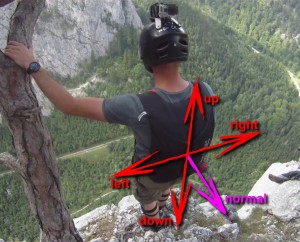
- Up – happens in head high / standing position.
- Down – happens in head low / head down position
- Left – when jumper rolls his body to the right side (right shoulder and hip down)
- Right – when jumper rolls his body to the left side (left sholder and hip down)
- Normal – when jumper is belly to earth
 I give the following names to the pin orientations when looking at the rig, happy and sad combined with side of the eye (eg. Happy left eye and sad left eye in the picture aside) and the parts of a pin.
I give the following names to the pin orientations when looking at the rig, happy and sad combined with side of the eye (eg. Happy left eye and sad left eye in the picture aside) and the parts of a pin.
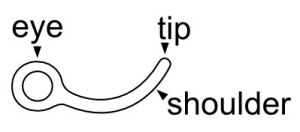 The following list of base rigs is far from complete, its just the rigs that I’ve played around with, but most likely you will be able to reproduce one or the scenario on a rig of another manufacturers that uses the same flap design. Also the listed issues is not necessarily complete, so if you find something on your rig please let me know! All rigs in the video had rather low pin tension, all of them can be opened in normal pull direction with less than 0.5kg force. (I’m aware of the fact that kg is not a unit for force…)
The following list of base rigs is far from complete, its just the rigs that I’ve played around with, but most likely you will be able to reproduce one or the scenario on a rig of another manufacturers that uses the same flap design. Also the listed issues is not necessarily complete, so if you find something on your rig please let me know! All rigs in the video had rather low pin tension, all of them can be opened in normal pull direction with less than 0.5kg force. (I’m aware of the fact that kg is not a unit for force…)
Zak 2, Hybrid, Ld+, Vertex (tuck-under, pin cannot rotate)
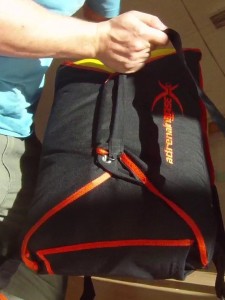 Pin protector flap is on the right side. (with the Vertex its exactly the other way round since pin protector flap is on the left side, description below is intended for Zak 2, so switch left and right for the Vertex) Flap is closed. When bridle is pulled up, the pin can now either rotate clockwise, in which case you’re fine and it will open normally, or counterclockwise, in which case the shoulder of the pin makes contact with the pin protector flap at its bottom end and cannot rotate further.
Pin protector flap is on the right side. (with the Vertex its exactly the other way round since pin protector flap is on the left side, description below is intended for Zak 2, so switch left and right for the Vertex) Flap is closed. When bridle is pulled up, the pin can now either rotate clockwise, in which case you’re fine and it will open normally, or counterclockwise, in which case the shoulder of the pin makes contact with the pin protector flap at its bottom end and cannot rotate further.
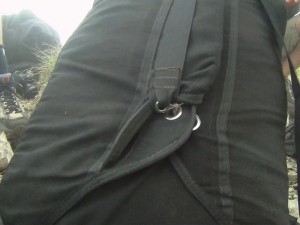 Severity: Requires quiet a surprising amount of force to open. Pull direction can be considered likely on a slider down jump, especially when doing gainers. Can be easily reproduced.
Severity: Requires quiet a surprising amount of force to open. Pull direction can be considered likely on a slider down jump, especially when doing gainers. Can be easily reproduced.
Remedy: Open pin protector flap, now the pin can rotate in both directions freely and everything is fine.
Perigee Pro, Zak 1, Apex DP (tuck-under, pin cannot rotate)
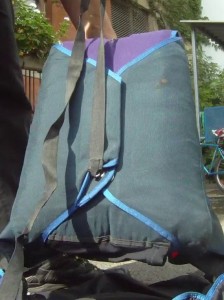 Flap is closed. When bridle is pulled up the pin can either rotate counterclockwise in which case you’re fine, or clockwise in which case the pin protector flap material is bunched up by the bridle pulling upwards. The pin then cannot rotate because its eye gets in contact with the bunched up flap material. (Apex DP locks when pin turns other way round, but locks for the same reason)
Flap is closed. When bridle is pulled up the pin can either rotate counterclockwise in which case you’re fine, or clockwise in which case the pin protector flap material is bunched up by the bridle pulling upwards. The pin then cannot rotate because its eye gets in contact with the bunched up flap material. (Apex DP locks when pin turns other way round, but locks for the same reason)
Severity: Requires so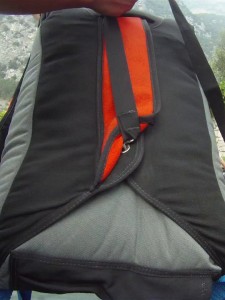 me additional force to open. Pull direction can be considered likely on a slider down jump, especially when doing gainers. Can be easily reproduced.
me additional force to open. Pull direction can be considered likely on a slider down jump, especially when doing gainers. Can be easily reproduced.
Remedy: Open pin protector flap, now the pin can rotate in both directions freely and everything is fine.
Additional info: Take care with the pin orientation, if the wrong bridle is used or bottom pin is put in wrong way round (still vertical eye pointing down, tip pointing right) the same lock described in the point above (Zak 2, Hybrid, Ld+, Vertex) can be produced but here the tip gets in contact with the pin protector at the bottom end.
Gargoyle, WsX, Razor (tuck-in, pin cannot rotate, not slide, bridle joint has to go around corner)
The pin protector flap is on the left flap, the tuck pocket is on the right flap. (at least on the rigs above)
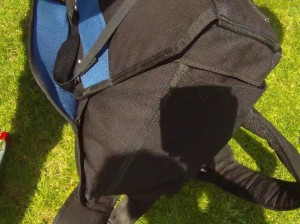 Scenario 1: Flap is open. When bridle is pulled right the pin cannot rotate because the edge of the tuck pocket gets in contact with the eye.
Scenario 1: Flap is open. When bridle is pulled right the pin cannot rotate because the edge of the tuck pocket gets in contact with the eye.
Severity: Requires additional force to open. Pull direction is quite unlikely unless doing barrel rolls. Can be produced within a few tries.
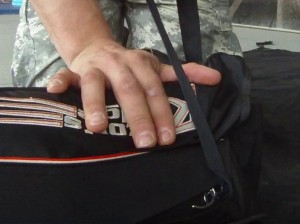 Scenario 2: Flap is open. Bridle is gently pulled down and then further until it pulls right, slowly turning the pin without sliding it or standing it up, or when pins are oriented vertically and bridle is pulled right, so that part of the eye of the pin can go under the tuck pocket on the right flap. Once there it cannot rotate further and cannot slide, if rotated a bit back it cannot slide because the bottom end of the tuck pocket is in the way.
Scenario 2: Flap is open. Bridle is gently pulled down and then further until it pulls right, slowly turning the pin without sliding it or standing it up, or when pins are oriented vertically and bridle is pulled right, so that part of the eye of the pin can go under the tuck pocket on the right flap. Once there it cannot rotate further and cannot slide, if rotated a bit back it cannot slide because the bottom end of the tuck pocket is in the way.
Severity: Force required to open this would probably damage something. Pull direction is quite unlikely unless doing barrel rolls. Takes some tries to reproduce, and does not work on all Rigs (due to different spacing between tuck pocket and grommet, but a little more on this further down)
Remedy: Pin orientation plays a big role so check it on exit and have them oriented horizontally reduces the likeliness of this by a lot.
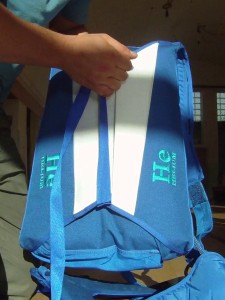 Scenario 3: Flap is closed. When bridle is pulled up, the stiff part of the bridle where the pin is sewn on is covered under the pin protector flap and has to be bent around the bottom corner of it.
Scenario 3: Flap is closed. When bridle is pulled up, the stiff part of the bridle where the pin is sewn on is covered under the pin protector flap and has to be bent around the bottom corner of it.
Severity: Requires some additional force. Pull direction can be considered likely on a slider down jump, especially when doing gainers. Can be easily reproduced.
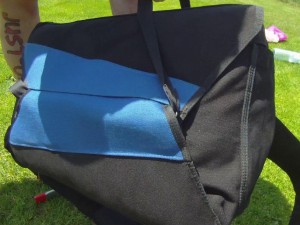 Scenario 4: Flap is closed. When bridle is pulled to the right, the stiff part of the bridle where the pin is sewn on has to be bent around the corner, additionally, the pin cannot rotate in the pull direction before the flap is opened.
Scenario 4: Flap is closed. When bridle is pulled to the right, the stiff part of the bridle where the pin is sewn on has to be bent around the corner, additionally, the pin cannot rotate in the pull direction before the flap is opened.
Severity: Requires quiet a surprising amount of force to open. Pull direction is quite unlikely unless doing barrel rolls. Can be easily reproduced.
Remedy: Open flap reduces it to scenario 1.
Additional info: Gargoyles became stiffer and stiffer over the years, so scenario 3 & 4 are less severe on old rigs that do not have any hard stiffener in the pin protector flap. On the other hand, the soft pin protector flap on those rigs get easily blown open on terminal jumps.
Apex TL, Summit (tuck-in, pin cannot slide)
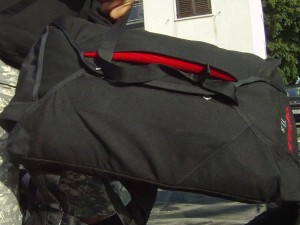 Update: Flap order is wrong on the picture aside and in video. (It should be left flap first). If rig is closed the right way (left flap first), the resulting issue is then the same as Scenario 2 with the Gargoyles, if the pins eye, or part of it, goes in/under the tuck pocket. See detailed description above.
Update: Flap order is wrong on the picture aside and in video. (It should be left flap first). If rig is closed the right way (left flap first), the resulting issue is then the same as Scenario 2 with the Gargoyles, if the pins eye, or part of it, goes in/under the tuck pocket. See detailed description above.
(Flap is open and folded back. When bridle is pulled left the pin rotates, but when it starts sliding the eye gets in contact with the edge of the tuck pocket under which the pin protector flap has been stowed away. Pin cannot slide further.
Severity: Requires some additional force. Pull direction is quite unlikely unless doing barrel rolls. Can be produced within a few tries.
Remedy: Leave pin protector flap open and not fold away, but this can potentially lead to similar problem at other pull angles.)
Prism (Single pin, kind of tuck-in, pin has to go around corner)
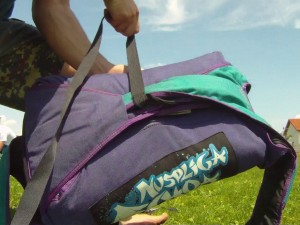 Rig has been retrofitted with a stiffer pin protector flap since it opened on every terminal jump. Flap is closed. When bridle is pulled left, the pin is rotated to horizontal, but pointing the wrong direction, the pin has to move around the pin protector flap.
Rig has been retrofitted with a stiffer pin protector flap since it opened on every terminal jump. Flap is closed. When bridle is pulled left, the pin is rotated to horizontal, but pointing the wrong direction, the pin has to move around the pin protector flap.
Severity: Requires some additional force. Pull direction is quite unlikely unless doing barrel rolls. Can be produced easily.
Remedy: Open pin protector flap.
Conclusion
- For all tuck-under style rigs the problem can be resolved by opening the pin protector flap. Air stream is not an issue even for longer slider down delays or aerials. The downside of the open flap is that pins and bridle are exposed to snag points on the exit, with some rigs though it is possible to open the flap yourself by reaching back just before jumping.
- For all tuck-in style rigs some problems still persist even with an open pin protector flap, although the pull angle is quite unusual and real locks are hard to reproduce.
- The stiffer the worse. The more stiffener material there is in the flaps and pin protector flap the easier it is to reproduce any of the above scenarios.
- Pin tension does not really play a big role in this.
- This whole article is focussed on the rig design, while the pin design stays untouched, although theres room for improvement. I’m aware of this, and i want to go deeper into that in another post.
My thoughts on flap designs
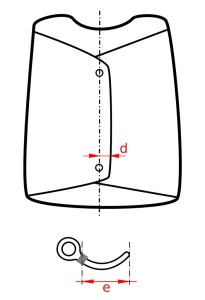 Tuck-unders: The main difference between the first and the second “pin lock” described in this post (shoulder of pin against inside of flap and eye of pin against bunched up flap) burns down to the relation between the distance of the grommet to the edge of the flap (d) and the maximum radius the pin needs to rotate around the loop (e). If the grommet is very close to the edge of the flap, therefore d considerably smaller than e, then the pin cannot rotate without getting in touch with the closed pin protector flap. One way to do this would be to move the grommet further in or the end of the closing flap further out, or by modifying the shape of the pin protector flap. (so that it would only cover but not tuck at the bottom). But by doing so one would eliminate the first, but not the second issue. Anyways, this whole problem can be resolved by opening the flap.
Tuck-unders: The main difference between the first and the second “pin lock” described in this post (shoulder of pin against inside of flap and eye of pin against bunched up flap) burns down to the relation between the distance of the grommet to the edge of the flap (d) and the maximum radius the pin needs to rotate around the loop (e). If the grommet is very close to the edge of the flap, therefore d considerably smaller than e, then the pin cannot rotate without getting in touch with the closed pin protector flap. One way to do this would be to move the grommet further in or the end of the closing flap further out, or by modifying the shape of the pin protector flap. (so that it would only cover but not tuck at the bottom). But by doing so one would eliminate the first, but not the second issue. Anyways, this whole problem can be resolved by opening the flap.
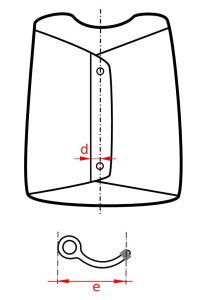 Tuck-ins: All “pin locks” described in the third and fourth point also burn down to a relation between pin length and something with the flap design. If the distance between the edge of the tuck pocket to the grommet/loop than the pins length from outside the eye to most outer loop position, the tuck pocket is close enough to obstruct the pin when rotating, or to obstruct the pin when it is pulled out of the loop. As described above, it helps to open the pin protector flap, but the issues still persist. Although the scenarios are less likely and harder to reproduce than the flap related ones.
Tuck-ins: All “pin locks” described in the third and fourth point also burn down to a relation between pin length and something with the flap design. If the distance between the edge of the tuck pocket to the grommet/loop than the pins length from outside the eye to most outer loop position, the tuck pocket is close enough to obstruct the pin when rotating, or to obstruct the pin when it is pulled out of the loop. As described above, it helps to open the pin protector flap, but the issues still persist. Although the scenarios are less likely and harder to reproduce than the flap related ones.
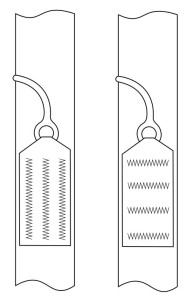 Bridles: The Bridle lock that was described above is of course getting worse the stiffer the bridle is and the harder it is to bend it lengthwise. On the newer Gargoyles the bartacks that join the bridle with the webbing piece that holds the pin are in line with the warp of the bridle (in the direction of the bridle), which makes it harder to bend the bridle at this point lengthwise than one where these bartacks would be in line with the weave.
Bridles: The Bridle lock that was described above is of course getting worse the stiffer the bridle is and the harder it is to bend it lengthwise. On the newer Gargoyles the bartacks that join the bridle with the webbing piece that holds the pin are in line with the warp of the bridle (in the direction of the bridle), which makes it harder to bend the bridle at this point lengthwise than one where these bartacks would be in line with the weave.
Thanks for the info.
Just a bit of confusion for the Perigee Pro. You said “if the wrong bridle is used or bottom pin is put in wrong way round (still vertical eye pointing down, tip pointing right)”
I thought this was the correct way as the pin will naturally rotate anti clockwise away from the flap wall and to the open side as to if the tip faces Left then the natural rotation will be clockwise towards the flap wall?
Could you please explain a bit more, Thanks
Let me try to explain. If the Perigee is set up properly and right bridle is used, and the pin rotates clockwise its shoulder would turn towards where the pin protector flap is tucked around. So this way the above described hesitation can happen.
If mirrored bridle is used or the joint that holds the pin on the bridle is twisted, when the pin rotates clockwise its tip rotates towards where the pin protector flap is tucked in, which can lead to a more sever hesitation/lock scenario than with correct bridle and pin orientation.